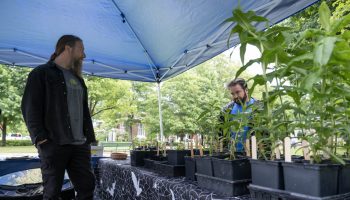
Every Wednesday and Friday since June 16, dozens of red-T-shirt-clad, smart-phone-wielding gardeners have peppered Chautauqua Institution’s gardens.
The mix of Chautauqua County Master Gardeners and Bird, Tree & Garden Club members gather to inventory each plant in the Institution’s dozens of public gardens: the flowers, shrubs, vines, trees, ground cover and more.
On their devices, volunteers log the individual plants by plant type, scientific name, state of growth, and more. This information, along with photos of each plant, is compiled into a master spreadsheet of the plant life on the grounds.
BTG President Angela James describes this plant census as a “fact-finding mission” for Betsy Burgeson, supervisor of gardens and landscapes at the Institution.
“We want to know: What are the assets that the Institution has purchased or what are the assets that we can quantify and qualify (how much it all costs)?” James said. “That’s why we differentiated the various types of grasses, the various vines, (and) the ferns since there’s a bajillion of them.”
Burgeson sees this as more than just as assets inventory — compiling this data will allow her to streamline plant care. Having this information at her fingertips will allow her to prepare and strategically manage plants in the case of an invasive bug species, harmful fungi, or species-specific disease.
“From a personal and supervisor management standpoint, just being able to know where all the types of a particular plant are (means that) if I know somebody really good at taking care of (a specific plant), I can send them to do that,” Burgeson said.
The volunteers completed their first round of inventory about a month into the project. But, with 25 gardens covered by July and nearly 300 types of perennials logged already, the work is only beginning.
“The cool thing about the plant census is that we’ve done the first pass,” James said. “We’ve been to every single garden, and now we’re going back because we look at three characteristics: is this plant emerging, in full bloom, or is it spent?”
The census will continue until around late September, once plants begin to wither as Western New York enters autumn. In the offseason, Burgeson will scrub and organize the data for accuracy. In the spring, volunteers will cover the grounds once again and start tracking garden growth from the first sprout.
Burgeson will use this data to map out the lifespan of plants. If someone is planning a visit to see a certain kind of greenery, Burgeson can help strategize the best time to visit. James can also take this information and enrich the local flora database already on BTG’s website.
From an ecologist’s standpoint, this information can help track environmental and growth patterns annually.
Plants are not equipped for all climates — so ecologists divide different regions into hardiness zones based on their environment — factoring in temperature extremes, precipitation, and seasons. Plants are then assorted into the various zones according to their needs.
With climate change, these long-established hardiness zones are beginning to shift north. The United States Department of Agriculture has classified Chautauqua County as zone five for the past 30 years — but a report from The New York Times speculates that the same space will be classified as zone six, approaching zone seven, in about 30 years.
Bugeson and BTG’s meticulous inventory will allow them to watch this change in real time.
“What they’ve been doing is taking pictures as (plants) bloom (to be able to) see when things are blooming each year,” Burgeson said. “It’ll be neat to compare, because the past couple years, for example, the milkweed — one year it bloomed on May 16. This year it didn’t bloom until almost the end of June.”
BTG sprung into action to start this project after the Institution announced it would move all of its 2020 programming online in May. They knew that their typical summer would not translate well to a virtual format, so they wanted to utilize the free time they found themselves with.
“Typically, BTG offers 90 programs a summer: lectures about the natural world, guided discovery tours, or the House and Garden Tour — boots on the ground, we’re all over the place,” James said. “But obviously since COVID came, there is nothing on the grounds. We thought we could do something better with our time than trying to figure out how to work with all our lecturers and guides to put stuff on Zoom.”
With Master Gardeners pouring in to help, James said it was a great opportunity to make connections.
“We reached out to the Cornell Cooperative Extension, and they have a whole group of Master Gardeners in Chautauqua County, so we invited them to come be part of the census,” James said. “It’s a wonderful opportunity for us to connect with a group that we probably haven’t connected with, even though we have something completely in common.”
Burgeson echoed James’ sentiment, and said she is grateful that all the volunteers were able to connect over a shared passion and help the Institution.
“It’s a great project for a year where it gives you something to look forward to,” Burgeson said. “Gardening always gives you something to look forward to. I really am thankful for what (the volunteers) have been doing and all the possibilities that are opening up, as well.”




